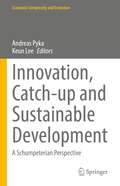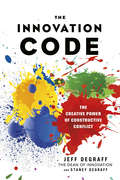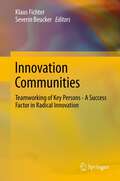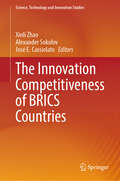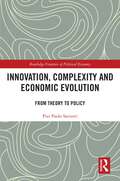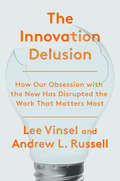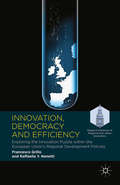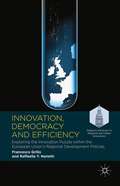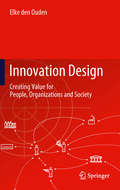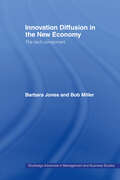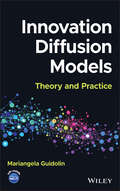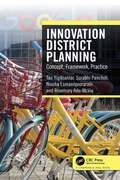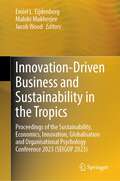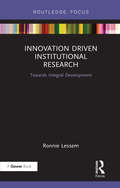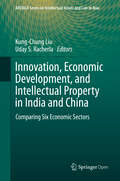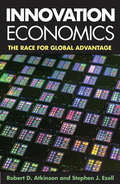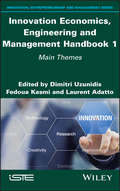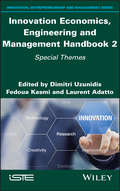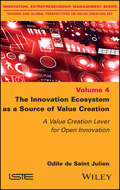- Table View
- List View
Innovation, Catch-up and Sustainable Development: A Schumpeterian Perspective (Economic Complexity and Evolution)
by Andreas Pyka Keun LeeThis volume presents selected contributions from the 2018 conference of the International Schumpeter Society (ISS). The selected chapters in this volume reflect the state-of-the-art of Schumpeterian economics dedicated to the three conference topics innovation, catch-up, and sustainability. Innovation is driving catch-up processes and is the condition for a transformation towards higher degrees of sustainability. Therefore, Schumpeterian economics has to play a key role in these most challenging fields of human societies’ development in the 21st century. The three topics are well suited to capture the great variety of issues, which have the potential to shape the scientific discussion in economics and related disciplines in the years to come. The presented contributions show the broadness and high standard of Schumpeterian analysis. The ideas of dynamics, heterogeneity, novelty, and innovation as well as transformation are the most attractive fields in economics today and offer the most prolific interdisciplinary connections now and for the years to come when humankind, our global society, has to master the transition towards sustainable economic systems by solving the grand challenges and wicked problems with which we are confronted today. Therefore, the book is a must-read for scholars, researchers, and students, interested in a better understanding of innovation, catch-up, and sustainability, and Schumpeterian economics in general.
The Innovation Code: The Creative Power of Constructive Conflict
by Jeff Degraff Staney DegraffThe Innovation CodeThe Creative Power of Constructive ConflictHarmony is sublime in music but deadly to innovation. The only way to create new, hybrid solutions is to clash. Innovation happens when we bring people with contrasting perspectives and complementary areas of expertise together in one room. We innovate best with people who challenge us, not people who agree with us. It sounds like a recipe for chaos and confusion. But in The Innovation Code, Jeff DeGraff, dubbed the “Dean of Innovation,” and Staney DeGraff introduce a simple framework to explain the ways different kinds of thinkers and leaders can create constructive conflict in any organization. This positive tension produces ingenious solutions that go far beyond “the best of both worlds.” Drawing on their work with nearly half of the Fortune 500 companies, the DeGraffs help you harness the creative energy that arises from opposing viewpoints. They identify four contrasting styles of innovator—the Artist, the Engineer, the Athlete, and the Sage—and include exercises and assessments for building, managing, and embracing the dynamic discord of a team that contains all four. You can also figure out where you fit on the continuum of innovator archetypes. Using vivid examples, The Innovation Code offers four steps to normalize conflict and channel it to develop something completely new. By following these simple steps, you will get breakthrough innovations that are both good for you and your customers. This is a rigorous but highly accessible guide for achieving breakthrough solutions by utilizing the full—and seemingly contradictory—spectrum of innovative thinking.
Innovation, Commercialization, and Start-Ups in Life Sciences
by James F. JordanInnovation is the translation of a new method, idea, or product into reality and profit. It is a process of connected steps that accumulates into your brand or reputation. However, there can be many pitfalls and wrong turns on the road to realizing this goal. Innovation, Commercialization, and Start-Ups in Life Sciences details the methodologies ne
Innovation, Commercialization, and Start-Ups in Life Sciences
by James F. JordanInnovation is a translation of a new method, idea, or product into reality and profit. It is a process of connected steps that accumulates into a brand reputation required for success. Unlike Fortune 500 companies, whose projects are self-funded, a start-up must simultaneously have a value proposition that attracts a customer (for revenue), investors (for capital), and acquirers (for a liquidity event or IPO). A high percentage of start-ups fail before attaining positive cashflow, due to a variety of reasons that are detailed in this book.Avoiding the pitfalls and wrong turns are the goals of this book. Innovation, Commercialization, and Start-Ups in Life Sciences details the methodologies necessary to create a successful life science start-up from initiation to exit. Written by an expert who has worked with more nearly 500 life science start-ups, this book discusses specific processes and investor milestones that must be navigated to align customer, funder, and acquirer needs. Successful commercialization requires attention to multiple constituents, such as investors, regulators, and customers. Investors require liquidity for their return, which is achieved through selling their stock in a public or private sale. The reader will gain an appreciation for the necessary data, partnerships, and skills needed to create a competitive and sustainable company. The author discusses such specific issues as customer problems, demonstrating sales access, and ensuring intellectual property is impervious to competitive advancement. This book is intended to be suitable for entrepreneurs, venture capitalists, and investors in both business and academic settings. These organizations have specific departments, such as R&D, operations, business development, legal, regulatory, and marketing, that would also benefit from this book.FEATURES Focuses specifically on life science start-ups Examines how to determine a company valuation and future "fundable milestones" Explores how to align regulatory and clinical strategies Discusses intellectual property derived from a university or individual through formation to exit. Reviews how start‐ups must simultaneously meet the needs of multiple constituencies at once: investors, regulators, customers and exit candidates James F. Jordan is an author, consultant, and speaker. He is a Distinguished Service Professor of Healthcare & Biotechnology Management, a former Fortune 100 executive, and a managing director of a venture fund.Access the Support Material: https://healthcaredata.center/ Cover design by Sarah Mailhott.
Innovation Communities: Teamworking of Key Persons - A Success Factor in Radical Innovation
by Klaus Fichter Severin BeuckerSelf-organising networks have become the dominant innovators of complex technologies and radical innovation. The growing need for co-operation to ensure innovation success calls for a broader understanding of what makes innovation projects successful and requires new concepts. The book introduces the new concept of "innovation communities", defining them as informal networks of like-minded individuals who act as innovation promotors or champions. These key figures come from various companies and organisations and will team up in a project-related fashion, jointly promoting a certain innovation, product or idea either on one or across different levels of an innovation system. The publication presents findings from surveys that demonstrate that networks of champions are a success factor in radical innovation. Five case studies of noteworthy innovation projects illustrate why the collaboration of champions can make innovation projects more successful. Furthermore, the book presents hands-on methods and includes best-practice cases and guidelines on how to develop innovation communities. This publication comprises empirical findings and practical experiences that are valuable for the following groups in particular: Entrepreneurs; Innovation, R&D, and network managers; Innovation and strategy consultants; Innovation and start-up intermediaries; Innovation researchers; Government officials and politicians responsible for R&D and innovation programmes and funding
The Innovation Competitiveness of BRICS Countries (Science, Technology and Innovation Studies)
by Xinli Zhao Alexander Sokolov José E. CassiolatoThe book is devoted to the assessment of innovation competitiveness of BRICS countries. It covers different aspects of science, technology and innovation in BRICS including status of STI in each country, the intra-BRICS collaboration in the field of STI, prospects of collaboration with BRICS+ countries, as well as a special chapter covering innovation development of BRICS in ICT. The book presents chapters authored by leading experts in STI policy and analysis from BRICS countries. The key questions addressed in the book cover peculiarities of national innovation systems of BRICS countries, their science, technology and innovation policies.
Innovation, Complexity and Economic Evolution: From Theory to Policy (Routledge Frontiers of Political Economy)
by Pier Paolo SaviottiIf evolutionary economics is to compete with neoclassical economics as a general-purpose economic theory, it needs to incorporate new aspects of socioeconomic reality, such as institutions of all types, including technical, scientific, and political. Furthermore, evolutionary economics needs to be able to provide policy implications at least as interesting as those of neoclassical economics. Thus, as this book argues, evolutionary economics must become evolutionary political economy. Innovation plays a central role in the book, but not in the sense of providing a technologically determinist interpretation. Rather, the book argues that innovations do not emerge in isolation from other components of socioeconomic systems but coevolve with institutions, infrastructures and organizational forms. This concept of coevolution is absolutely central in the book and provides a link with theories of complexity. In addition to providing an epistemological basis for evolutionary economics, the link with complexity and coevolution offers the connection with evolutionary political economy. Innovations and technologies do not emerge and develop in an institutional vacuum, but interact with existing institutions and reshape them, in addition to inducing the formation of new institutions. In this process, technologies and institutions reinforce each other providing a potential mechanism to transform socioeconomic systems. The book also explores the policy implications of these innovative societies, where wealth is created but unequally distributed. The book is addressed to open-minded economists, social scientists who are dissatisfied with the approach of neoclassical economics, technologists and policy makers.
Innovation Corrupted: The Rise and Fall of Enron (A)
by Malcolm S. SalterPresents a brief historical overview of Enron's rise, its strategic successes and failures, the evolution of its business model, and the organizational processes relied upon by Enron's management to drive and monitor the business. A rewritten version of an earlier case.
The Innovation Delusion: How Our Obsession with the New Has Disrupted the Work That Matters Most
by Lee Vinsel Andrew L. RussellInnovation is the hottest buzzword in business. But what if our obsession with finding the next big thing has distracted us from the work that matters most?&“The most important book I&’ve read in a long time . . . It explains so much about what is wrong with our technology, our economy, and the world, and gives a simple recipe for how to fix it: Focus on understanding what it takes for your products and services to last.&”—Tim O&’Reilly, founder of O&’Reilly Media It&’s hard to avoid innovation these days. Nearly every product gets marketed as being disruptive, whether it&’s genuinely a new invention or just a new toothbrush. But in this manifesto on thestate of American work, historians of technology Lee Vinsel and Andrew L. Russell argue that our way of thinking about and pursuing innovation has made us poorer, less safe, and—ironically—less innovative. Drawing on years of original research and reporting, The Innovation Delusion shows how the ideology of change for its own sake has proved a disaster. Corporations have spent millions hiring chief innovation officers while their core businesses tank. Computer science programs have drilled their students on programming and design, even though theoverwhelming majority of jobs are in IT and maintenance. In countless cities, suburban sprawl has left local governments with loads of deferred repairs that they can&’t afford to fix. And sometimes innovation even kills—like in 2018 when a Miami bridge hailed for its innovative design collapsed onto a highway and killed six people. In this provocative, deeply researched book, Vinsel and Russell tell the story of how we devalued the work that underpins modern life—and, in doing so, wrecked our economy and public infrastructure while lining the pockets of consultants who combine the ego of Silicon Valley with the worst of Wall Street&’s greed. The authors offer a compelling plan for how we can shift our focus away from the pursuit of growth at all costs, and back toward neglected activities like maintenance, care, and upkeep. For anyone concerned by the crumbling state of our roads and bridges or the direction our economy is headed, The Innovation Delusion is a deeply necessary reevaluation of a trend we can still disrupt.
Innovation, Democracy and Efficiency: Exploring the Innovation Puzzle within the European Union’s Regional Development Policies (Palgrave Advances in Regional and Urban Economics)
by Francesco Grillo Raffaella Y. NanettiEndogenous growth theory has significantly impacted most of the developing and developed countries, shifting priorities of industrial policies towards innovation. In line with this trend, the European Union significantly increased its budgetary allocation for R&D. However, statistical data show a weak correlation between R&D expenditure and the acceleration of economic growth. Regional innovation policies display divergent returns according to different institutional conditions and policy choices.Grillo and Nanetti attempt to understand the reasons that lie behind differences in performance. Their results show that better performing innovation strategies require the following factors: clear choices of locally congruent smart specialization; strong capacity of public investment to stimulate additional private investment; clear distribution of responsibilities for decision-making and independence of policy implementation from political interference; and problem solving partnerships amongst innovators, universities, and governments that pre-exist the programmes. These factors point to a relationship between democracy (defined as openness of policy-making) and innovation (as technology-enabled growth) which is explored throughout this book.
Innovation, Democracy and Efficiency: Exploring the Innovation Puzzle within the European Union's Regional Development Policies (Palgrave Advances In Regional And Urban Economics)
by Raffaella Y. Nanetti Francesco GrilloInnovation, Democracy and Efficiency.
Innovation Design
by Elke Den OudenInnovation Design presents an approach to designing shared value for businesses, non-profit organizations, end-users and society. The societal and economic challenges we are currently facing - such as the aging population, energy scarcity and environmental issues - are not just threats but are also great opportunities for organizations. Innovation Design shows how organizations can contribute to the process of generating value for society by finding true solutions to these challenges. And at the same time it describes how they can capture value for themselves in business ecosystems that care for both people and planet. This book covers: creating meaningful innovations that improve quality of life, engage users and provide value for organizations and other stakeholders, guiding the creation of shared value throughout the innovation process, with a practical and integrative approach towards value that connects ideas from economics, psychology, sociology and ecology, designing new business models and business ecosystems to deliver sustainable benefits for all the involved parties and stakeholders, addressing both tangible and intangible value. Innovation Design gives numerous examples of projects and innovations to illustrate some of the challenges and solutions you may encounter in your journey of designing meaningful innovations and creating shared value. It also offers practical methods and tools that can be applied directly in your own projects. And in a fast-changing world, it provides a context, a framework and the inspiration to create value at every level: for people, for organizations and for the society in which we live.
Innovation Diffusion in the New Economy: The Tacit Component (Routledge Advances In Management And Business Studies)
by Barbara Jones Bob MillerThis book unites discussions of the philosophical and scientific basis of tacit knowledge.The authors give an overview of the theories of tacit knowledge and explain how these relate to a background of philosophical, neurological and pedagogic literature. The importance of tacit knowledge for evolutionary models of innovation is analyzed raising qu
Innovation Diffusion Models: Theory and Practice
by Mariangela GuidolinInnovation Diffusion Models Understand innovation diffusion models and their role in business success Innovation diffusion models are statistical models that predict the medium- and long-term sales performance of new products on a market. They account for numerous factors that contribute to the life cycle of a new product and are subject to continuous reassessment as markets transform and the business world becomes more complex. In a modern market environment where product life cycles are becoming ever shorter, the latest innovation diffusion models are essential for businesses looking to perfect their decision-making processes. Innovation Diffusion Models: Theory and Practice provides a comprehensive and up-to-date guide to these models and their potential to impact product development. It focuses on the latest product diffusion models, which combine time series analysis with nonlinear regression techniques to create increasingly refined predictions. Its combination of mathematical theory and business practice makes it an indispensable tool across many sectors of industry and commerce. Innovation Diffusion Models readers will also find: Real-world examples demonstrating the kinds of data sets generated by new product growth models and their potential applications Discussion of the factors underlying the decision to select a given growth model for a particular product Clear, detailed explanation of each model’s explanatory ability Innovation Diffusion Models is an essential volume for practitioners in any field of industry or commerce, as well as for graduate students and researchers in business and finance.
Innovation District Planning: Concept, Framework, Practice
by Tan Yigitcanlar Surabhi Pancholi Niusha Esmaeilpoorarabi Rosemary Adu-McVieThis book aims to fill the knowledge gap on how to plan, develop and manage innovation districts that are competitive in terms of both productivity and quality of living, justifying the massive investment put into place and at the same time doing both in a delicate and harmonious way.There is a need for smart urban land use that is wired with both hard infrastructures (e.g., telecommunication and transport) and soft infrastructures (e.g., diversity and tolerance). The reader learns this knowledge through conceptual expansions for key insights, frameworks for potential and performance assessment and best practices for global innovation districts. The authors begin innovation district planning with the role and effectiveness of planning a branding in the development of innovation districts. The next key topic of place making is recognised as a key strategy for supporting knowledge generation and innovation activities in the contemporary innovation districts. Another important topic is place quality where the reader learns to identify and classify indicators of place quality by studying global innovation districts best practices. The reader also expands their understanding on the classification of innovation districts based on their key characteristics through a methodological approach. The book concludes with district smartness studied through the socio-cultural role played by anchor universities in facilitating place making in innovation districts. Smart campuses, enabled by digital transformation opportunities in higher education, are seen as a miniature replica of smart cities and serve as living labs for smart technology.The book serves as a repository for scholars, researchers, postgraduate and undergraduate students as it communicates the complex innovation district phenomenon in an easy-to-digest form by providing both the big picture view and specifics of each component of that view.
Innovation-Driven Business and Sustainability in the Tropics: Proceedings of the Sustainability, Economics, Innovation, Globalisation and Organisational Psychology Conference 2023 (SEIGOP 2023)
by Emiel L. Eijdenberg Malobi Mukherjee Jacob WoodThe edited volume presents the conference proceedings from the “Sustainability, Economics, Innovation, Globalisation and Operational Psychology Conference 2023” (SEIGOP 2023), organized by the Centre for International Trade and Business in Asia (CITBA) at James Cook University, Singapore. This edited volume places the highly dynamic, but also, jeopardized climatological – geographical region of the Tropics centre stage. The region is developing rapidly, with significant progress being made through the development of innovative technologies. The Tropics represent a region in which people live amid the greatest level of biodiversity anywhere on the planet. Nonetheless, propelled by rapid population growth, the Tropics is a region on the rise, with higher living standards and increased levels of international trade and investment. Densely populated emerging countries like India, Indonesia and Nigeria will be among the largest economies of the world by the end of the century. These upward socioeconomic trends are compromised by the impact of climate change on the Tropics’ biodiversity. Such developments have forced policymakers, businesses, and local communities to search for more sustainable and creative ways to live and work. For these reasons, this edited volume presents theory-driven conceptual, qualitative, quantitative and mixed-methods studies on the impact of innovation-driven businesses on the complex interplay of socio-cultural, economic, and environmental factors in the Tropics.
Innovation Driven Institutional Research: Towards Integral Development (Transformation and Innovation)
by Ronnie LessemThis is the third volume in the CARE-ing for Integral Development series. It continues to build on the previous two works, Community Activation and Awakening Integral Consciousness, as well as preceding the fourth and final book, Embodying Integral Development. This book serves as a follow-up to the author's approach to integral research and development, economics and enterprise, contained within the Innovation and Transformation series, and as a focus for how put all of this "CARE-fully" to work. This third volume, in the CAREquartet is perhaps the most crucial one, building on the organizational systems (see Awakening Integral Consciousness) that came before and turning from trans-cultural and transformational to trans-disciplinary, from integral reality and integral rhythm to integral realms, with a view ultimately to transpersonal, integral rounds. The author turns his attention to research and innovation, and then focuses in on enterprise and economics, management and leadership. As such, he introduces his Inter-Institutional Genealogyin place of an "integral", yet still inhibiting, university. In the process this book paves the way for a new kind of institutionalized, innovation driven social research, which, while rooted in a particular place, speaks to the world as a whole. Moreover, such a research-and-innovation institution has a fundamental role to play in the evolution of a specific community, building on what has come CARE-wise before.
Innovation Drivers and Regional Innovation Strategies (Routledge Studies in Innovation, Organizations and Technology)
by Andrés Rodriguez-Pose M. Davide Parrilli Rune Dahl FitjarIn the global economy, regional development and innovation are increasingly an imperative to increase the competitive edge of EU economies. While European regions are different in many ways, the innovation capacity of regions, clusters and firms is what makes them capable of building up new and diversified pathways for sustainable growth. For this reason, Innovation Drivers and Regional Innovation Strategies looks to analyze different knowledge drivers (e.g. entrepreneurial or policy-orientation; scientific and practice-based knowledge modes; institutional innovation support) that influence the innovative and competitive capacity of regions, clusters and firms in Europe. The aim of this volume is to develop an in-depth understanding of these drivers and their implications for the way in which regional and cluster growth may be upgraded. Innovation Drivers and Regional Innovation Strategies examines the construction of new innovation pathways for regions and clusters in different geographical contexts. The main themes are cluster evolution, regional innovation systems and business innovation modes and capabilities. The objectives are centred on exploring the logic and mechanisms that can be activated as a means to promote innovation and competitiveness within regions and, within these, across and within firms. Aimed at researchers and academics in the field, this is a thoughtful and innovative new volume that helps define the academic debate.
Innovation durch Management des Informellen
by Markus Bürgermeister Fritz Böhle Stephanie PorschenIn diesem Buch zeigen die Autoren, wo die Erfolgspotenziale bei Organisationen liegen und wie sie mithilfe von Managementstrategien sowie Organisations-, Personal- und Kompetenzentwicklungskonzepten realisiert werden können. Die im Verbundprojekt KES-MI (www.kes-mi.de) erarbeiteten Instrumente zielen darauf ab, Unbestimmtheit und Offenheit als Charakteristika innovativer Arbeitsprozesse nicht nur zuzulassen, sondern diese Eigenschaften als Potenzial zur Steigerung der Innovationsfähigkeit zu nutzen und zu fördern.
Innovation, Economic Development, and Intellectual Property in India and China: Comparing Six Economic Sectors (ARCIALA Series on Intellectual Assets and Law in Asia)
by Kung-Chung Liu Uday S. RacherlaThis open access book analyses intellectual property codification and innovation governance in the development of six key industries in India and China. These industries are reflective of the innovation and economic development of the two economies, or of vital importance to them: the IT Industry; the film industry; the pharmaceutical industry; plant varieties and food security; the automobile industry; and peer production and the sharing economy.The analysis extends beyond the domain of IP law, and includes economics and policy analysis. The overarching concern that cuts through all chapters is an inquiry into why certain industries have developed in one country and not in the other, including: the role that state innovation policy and/or IP policy played in such development; the nature of the state innovation policy/IP policy; and whether such policy has been causal, facilitating, crippling, co-relational, or simply irrelevant. The book asks what India and China can learn from each other, and whether there is any possibility of synergy.The book provides a real-life understanding of how IP laws interact with innovation and economic development in the six selected economic sectors in China and India. The reader can also draw lessons from the success or failure of these sectors.
Innovation Economics
by Robert D. AtkinsonThis important book delivers a critical wake-up call: a fierce global race for innovation advantage is under way, and while other nations are making support for technology and innovation a central tenet of their economic strategies and policies, America lacks a robust innovation policy. What does this portend? Robert Atkinson and Stephen Ezell, widely respected economic thinkers, report on profound new forces that are shaping the global economy—forces that favor nations with innovation-based economies and innovation policies. Unless the United States enacts public policies to reflect this reality, Americans face the relatively lower standards of living associated with a noncompetitive national economy. The authors explore how a weak innovation economy not only contributed to the Great Recession but is delaying America's recovery from it and how innovation in the United States compares with that in other developed and developing nations. Atkinson and Ezell then lay out a detailed, pragmatic road map for America to regain its global innovation advantage by 2020, as well as maximize the global supply of innovation and promote sustainable globalization.
Innovation Economics, Engineering and Management Handbook 1: Main Themes
by Dimitri Uzunidis Fedoua Kasmi Laurent AdattoInnovation, in economic activity, in managerial concepts and in engineering design, results from creative activities, entrepreneurial strategies and the business climate. Innovation leads to technological, organizational and commercial changes, due to the relationships between enterprises, public institutions and civil society organizations. These innovation networks create new knowledge and contribute to the dissemination of new socio-economic and technological models, through new production and marketing methods. Innovation Economics, Engineering and Management Handbook 1 is the first of the two volumes that comprise this book. The main objectives across both volumes are to study the innovation processes in today's information and knowledge society; to analyze how links between research and business have intensified; and to discuss the methods by which innovation emerges and is managed by firms, not only from a local perspective but also a global one. The studies presented in these two volumes contribute toward an understanding of the systemic nature of innovations and enable reflection on their potential applications, in order to think about the meaning of growth and prosperity.
Innovation Economics, Engineering and Management Handbook 2: Special Themes
by Dimitri Uzunidis Fedoua Kasmi Laurent AdattoInnovation, in economic activity, in managerial concepts and in engineering design, results from creative activities, entrepreneurial strategies and the business climate. Innovation leads to technological, organizational and commercial changes, due to the relationships between enterprises, public institutions and civil society organizations. These innovation networks create new knowledge and contribute to the dissemination of new socio-economic and technological models, through new production and marketing methods. Innovation Economics, Engineering and Management Handbook 2 is the second of the two volumes that comprise this book. The main objectives across both volumes are to study the innovation processes in today's information and knowledge society; to analyze how links between research and business have intensified; and to discuss the methods by which innovation emerges and is managed by firms, not only from a local perspective but also a global one. The studies presented in these two volumes contribute toward an understanding of the systemic nature of innovations and enable reflection on their potential applications, in order to think about the meaning of growth and prosperity
The Innovation Ecosystem as a Source of Value Creation: A Value Creation Lever for Open Innovation
by Odile de Saint JulienEcosystems have been present in the fields of economics and management for decades, and in recent years they have experienced rapid development. However, there is still no consensus on the definition of an innovation ecosystem.Using concrete examples, The Innovation Ecosystem as a Source of Value Creation proposes a unique model in order to refine the understanding, functions, advantages and disadvantages of innovation ecosystems. This model is based on both the iterative network and integrated value chain. The network supports the collaboration between actors and favors asset transfers articulated around the innovation process.This book highlights the transfer processes at work in the innovation ecosystem, as well as the roles of the actors in this integrated value chain. It presents how value creation is articulated around knowledge to generate value shared by all of the actors in the innovation ecosystem.
Innovation Ecosystems: Increasing Competitiveness
by Martin FransmanMartin Fransman presents a new approach to understanding how innovation happens, who makes it happen, and the helps and hindrances. Looking at innovation in real-time under uncertainty, he develops the idea of an 'innovation ecosystem', i.e. a system of interrelated players and processes that jointly make innovation happen. Examples include: how companies like Amazon, Google, Facebook, Apple, AT&T, and Huawei interact in the ICT Ecosystem; four innovations that changed the world - the transistor, microprocessor, optical fibre, and the laser; the causes of the telecoms boom and bust of the early 1990s that influenced the Great Recession from 2007; and the usefulness of the idea of innovation ecosystems for Chinese policy makers. By delving into the complex determinants of innovation this book provides a deeper, more rigorous understanding of how it happens. It will appeal to economists, social scientists, business people, policy makers, and anyone interested in innovation and entrepreneurship.
